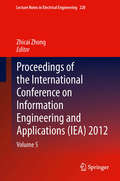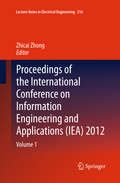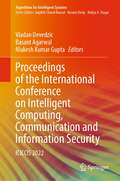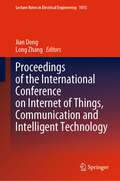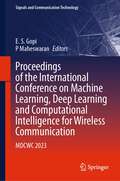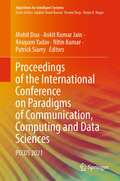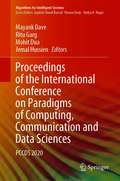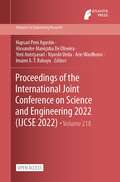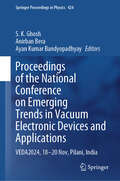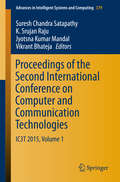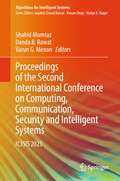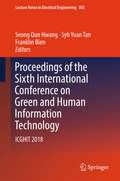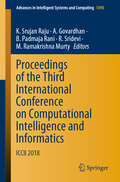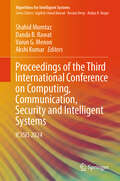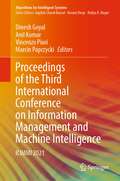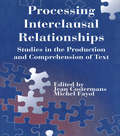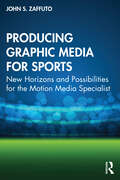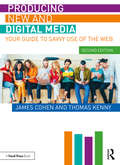- Table View
- List View
Proceedings of the International Conference on Information Engineering and Applications (IEA) 2012: 220
by Zhicai ZhongInformation engineering and applications is the field of study concerned with constructing information computing, intelligent systems, mathematical models, numerical solution techniques, and using computers and other electronic devices to analyze and solve natural scientific, social scientific and engineering problems. <P><P> Information engineering is an important underpinning for techniques used in information and computational science and there are many unresolved problems worth studying. The Proceedings of the 2nd International Conference on Information Engineering and Applications (IEA 2012), which was held in Chongqing, China, from October 26-28, 2012, discusses the most innovative research and developments including technical challenges and social, legal, political, and economic issues.<P> A forum for engineers and scientists in academia, industry, and government, the Proceedings of the 2nd International Conference on Information Engineering and Applications presents ideas, results, works in progress, and experience in all aspects of information engineering and applications.
Proceedings of the International Conference on Information Engineering and Applications (IEA) 2012: Volume 1
by Zhicai ZhongInformation engineering and applications is the field of study concerned with constructing information computing, intelligent systems, mathematical models, numerical solution techniques, and using computers and other electronic devices to analyze and solve natural scientific, social scientific and engineering problems. <P><P> Information engineering is an important underpinning for techniques used in information and computational science and there are many unresolved problems worth studying. The Proceedings of the 2nd International Conference on Information Engineering and Applications (IEA 2012), which was held in Chongqing, China, from October 26-28, 2012, discusses the most innovative research and developments including technical challenges and social, legal, political, and economic issues.<P> A forum for engineers and scientists in academia, industry, and government, the Proceedings of the 2nd International Conference on Information Engineering and Applications presents ideas, results, works in progress, and experience in all aspects of information engineering and applications.
Proceedings of the International Conference on Intelligent Computing, Communication and Information Security: ICICCIS 2022 (Algorithms for Intelligent Systems)
by Basant Agarwal Mukesh Kumar Gupta Vladan DevedzicThis book contains high quality research papers accepted and presented at the International Conference on Intelligent Computing, Communication and Information Security (ICICCIS 2022), organized by Swami Keshvanand Institute of Technology, Management & Gramothan (SKIT), Jaipur, India during 25-26, November 2022. It presents the solutions of issues and challenges in intelligent computing, communication and information security domains. This book provides a background to problem domains, considering the progress so far, assessing the potential of such approaches, and exploring possible future directions as a single readily accessible source.
Proceedings of the International Conference on Internet of Things, Communication and Intelligent Technology (Lecture Notes in Electrical Engineering #1015)
by Long Zhang Jian DongThis book includes original, peer-reviewed research papers from the International Conference on Internet of Things, Communication and Intelligent Technology (IoTCIT) 2022. It contains the application of communication and IoT engineering in the age of intelligent technology+ from the standpoint of disciplinary integration, combining theory and associated IoT and intelligent technology algorithms. The topics cover the full range of IoT solutions, from IoT to network security, and focus on many forms of communication, such as Next Generation (6G) Mobile Communication, D2D, and M2M Communication. Additionally, it examines Intelligent Technology, with a focus on Information System Modeling and Simulation. It also explores Cloud Computing, Pervasive and Mobile Computing, Distributed Computing, High Performance Computing, and Ubiquitous Computing.
Proceedings of the International Conference on Machine Learning, Deep Learning and Computational Intelligence for Wireless Communication: MDCWC 2023 (Signals and Communication Technology)
by E. S. Gopi P MaheswaranThis book is a collection of best selected research papers presented at the 2nd Conference on Machine Learning, Deep Learning and Computational Intelligence for Wireless Communication (MDCWC 2023) held during June 22-24th, 2023, at the National Institute of Technology Tiruchirappalli, India. The presented papers are grouped under the following topics (a) Machine learning, Deep learning and Computational intelligence algorithms (b) Wireless communication systems and (c) Mobile data applications. The topics include the latest research and results in the areas of network prediction, traffic classification, call detail record mining, mobile health care, mobile pattern recognition, natural language processing, automatic speech processing, mobility analysis, indoor localization, wireless sensor networks (WSN), energy minimization, routing, scheduling, resource allocation, multiple access, power control, malware detection, cyber security, flooding attacks detection, mobile apps sniffing, MIMO detection, signal detection in MIMO-OFDM, modulation recognition, channel estimation, MIMO nonlinear equalization, super-resolution channel and direction-of-arrival estimation. The book is a rich reference material for academia and industry.
Proceedings of the International Conference on Paradigms of Communication, Computing and Data Sciences: PCCDS 2021 (Algorithms for Intelligent Systems)
by Patrick Siarry Anupam Yadav Mohit Dua Ankit Kumar Jain Nitin KumarThis book gathers selected high-quality research papers presented at the International Conference on Paradigms of Communication, Computing and Data Sciences (PCCDS 2021), held at the National Institute of Technology, Kurukshetra, India, during May 07–09, 2021. It discusses high-quality and cutting-edge research in the areas of advanced computing, communications, and data science techniques. The book is a collection of latest research articles in computation algorithm, communication, and data sciences, intertwined with each other for efficiency.
Proceedings of the International Conference on Paradigms of Computing, Communication and Data Sciences: PCCDS 2020 (Algorithms for Intelligent Systems)
by Mayank Dave Ritu Garg Mohit Dua Jemal HussienThis book presents best selected papers presented at the International Conference on Paradigms of Computing, Communication and Data Sciences (PCCDS 2020), organized by National Institute of Technology, Kurukshetra, India, during 1–3 May 2020. It discusses high-quality and cutting-edge research in the areas of advanced computing, communications and data science techniques. The book is a collection of latest research articles in computation algorithm, communication and data sciences, intertwined with each other for efficiency.
Proceedings of the International Joint Conference on Science and Engineering 2022 (Advances in Engineering Research #218)
by Hapsari Peni Agustin Alexandre Maniçoba De Oliveira Yeni Anistyasari Kiyoshi Ueda Arie Wardhono Imami A. T. RahayuThis is an open access book.This joint conference features three international conferences: International Conference on Research and Academic Community Services (ICRACOS); Mathematics, Informatics, Science, and Education International Conference (MISEIC), and International Conference on Vocational Education and Electrical Engineering (ICVEE).It encourages dissemination of ideas in Computer Science, Applied science on engineering, and Engineering and provides a forum for intellectuals from all over the world to discuss and present their research findings on the research areas. This conference will be held in Surabaya, East Java, Indonesia on September 10, 2022 – September 11, 2022.We are inviting academics, researchers, and practitioners to submit research-based papers that address any topics within the broad areas of Computer Science, Applied science on engineering, and Engineering .
Proceedings of the International e-Conference on Intelligent Systems and Signal Processing: e-ISSP 2020 (Advances in Intelligent Systems and Computing #1370)
by Yu-Chen Hu Falgun Thakkar Geetali Saha Celia ShahnazThis book provides insights into the Third International Conference on Intelligent Systems and Signal Processing (eISSP 2020) held By Electronics & Communication Engineering Department of G H Patel College of Engineering & Technology, Gujarat, India, during 28–30 December 2020. The book comprises contributions by the research scholars and academicians covering the topics in signal processing and communication engineering, applied electronics and emerging technologies, Internet of Things (IoT), robotics, machine learning, deep learning and artificial intelligence. The main emphasis of the book is on dissemination of information, experience and research results on the current topics of interest through in-depth discussions and contribution of researchers from all over world. The book is useful for research community, academicians, industrialists and postgraduate students across the globe.
Proceedings of the Multimedia University Engineering Conference (Advances in Engineering Research #214)
by Mohamad Yusoff bin AliasThis is an open access book.The Multimedia University Engineering Conference 2022 (MECON 2022) aims to bring together related research scholars, educators, practitioners, policy makers, enthusiasts, fellow students, and industries to share and exchange their research experiences and results on all aspects of engineering technologies from various perspectives, disciplines, and fields. It also offers an interdisciplinary platform for all stakeholders to present and discuss the most latest trends, innovations, and concerns as well as practical challenges encountered, and solutions adopted in the realm of engineering technologies. This conference is being co-organised by the Faculty of Engineering (FOE) and Faculty of Engineering and Technology (FET), Multimedia University. MECON 2022 carries the theme `Sustainable Engineering for a Sustainable Future’.
Proceedings of the National Conference on Emerging Trends in Vacuum Electronic Devices and Applications: VEDA2024, 18-20 Nov, Pilani, India (Springer Proceedings in Physics #424)
by S. K. Ghosh Anirban Bera Ayan Kumar BandyopadhyayThis book presents peer reviewed articles from the Conference on Vacuum Electronic Devices Applications (VEDA2024) held at Pilani in India. Like its previous editions, it focusses on new ideas and the latest developments in research and industry on topics like technologies for vacuum electron devices (VEDs) or Systems and Subsystems employing VEDs, RF, HPM, and THz Components, Devices & Systems, RF, MW & mm-wave, Antennas and EM Simulations, Materials, power systems and components for VEDs, High emission density cathodes for VEDs, Applications of VEDs, Future trends & competing technologies. It brings together scientists, industrialists, academicians, and research scholars to exchange ideas and present latest developments in the field.
Proceedings of the Second Global Forum on Space Information for Sustainable Development: GFSISD 2024, 25–28 September, Guangzhou, China (Springer Proceedings in Physics #417)
by Ge LuoThis proceedings book gathers the latest research presented at the Second Global Forum on Space Information for Sustainable Development (GFSISD 2024) which hosted by China Association of Remote Sensing Application (CARSA), supported by Guangzhou Association For Science & Technology and took place in Guangzhou, Guangdong Province, China, from September 25th to 28th, 2024”. The forum aimed to investigate the important role of remote sensing in fostering environmental conservation and sustainable development. Both the forum and this proceedings volume address interdisciplinary areas including space information, earth system science, social sciences, economics, and sustainable development. It highlights the enhanced application of spatial information and big data derived from remote sensing in areas such as climate change response, disaster risk reduction, food security, energy and resource management, environmental protection, biodiversity preservation, public health, traffic management, and ocean monitoring. The book provides extensive coverage of three specific goals within the United Nations' 2030 Agenda for Sustainable Development: Goal 2—Zero Hunger, which encompasses sustainable agriculture; Goal 14—Life Below Water, which emphasizes the sustainable use of marine resources; and Goal 15—Life On Land, which focuses on the sustainable use of terrestrial ecosystems. Furthermore, the publication covers the methodologies and applications of remote sensing sensors (both optical and radar) that contribute to sustainability efforts. Contributors to these proceedings include distinguished scholars and industry leaders from across the globe. This collection serves as a valuable resource for researchers, students, professionals, and policymakers involved in space science, information science, earth and environmental sciences, and sustainable development.
Proceedings of the Second International Conference on Artificial Intelligence and Communication Technologies: Network Technologies, AI and DL, Volume 2 (Smart Innovation, Systems and Technologies #425)
by Lakhmi C. Jain Srikanta Patnaik Kazumi Nakamatsu Roumiana KountchevaThis book gathers selected papers presented at the International Conference on Artificial Intelligence and Communication Technologies (ICAICT2024), held at Shenzhen, China during June 2024. The book focuses on the newest methods and algorithms in smart wireless communications in the areas of remote sensing and machine learning, intelligent image and data processing, health systems and security, intelligent teaching applications, and many others.
Proceedings of the Second International Conference on Artificial Intelligence and Communication Technologies: Smart Wireless Communications — Methods and Algorithms, Volume 1 (Smart Innovation, Systems and Technologies #424)
by Lakhmi C. Jain Kazumi Nakamatsu Roumiana KountchevaThis book gathers selected papers presented at the International Conference on Artificial Intelligence and Communication Technologies (ICAICT2024), held at Shenzhen, China during June 2024. The first volume of the proceedings is focused on the newest methods and algorithms in smart wireless communications in the areas of remote sensing and machine learning, intelligent image and data processing, health systems and security, intelligent teaching applications and many others.
Proceedings of the Second International Conference on Computational Intelligence and Informatics: ICCII 2017 (Advances in Intelligent Systems and Computing #712)
by Vikrant Bhateja K. Srujan Raju V. Kamakshi Prasad B. Padmaja Rani João Manuel TavaresThe volume contains 69 high quality papers presented at International Conference on Computational Intelligence and Informatics (ICCII 2017). The conference was held during 25-27, September, 2017 at Department of Computer Science and Engineering, JNTUHCEH, Hyderabad, Telangana, India. This volume contains papers mainly focused on data mining, wireless sensor networks, parallel computing, image processing, network security, MANETS, natural language processing, and internet of things.
Proceedings of the Second International Conference on Computer and Communication Technologies
by Suresh Chandra Satapathy Jyotsna Kumar Mandal Vikrant Bhateja K. Srujan RajuThe book is about all aspects of computing, communication, general sciences and educational research covered at the Second International Conference on Computer & Communication Technologies held during 24-26 July 2015 at Hyderabad. It hosted by CMR Technical Campus in association with Division - V (Education & Research) CSI, India. After a rigorous review only quality papers are selected and included in this book. The entire book is divided into three volumes. Three volumes cover a variety of topics which include medical imaging, networks, data mining, intelligent computing, software design, image processing, mobile computing, digital signals and speech processing, video surveillance and processing, web mining, wireless sensor networks, circuit analysis, fuzzy systems, antenna and communication systems, biomedical signal processing and applications, cloud computing, embedded systems applications and cyber security and digital forensic. The readers of these volumes will be highly benefited from the technical contents of the topics.
Proceedings of the Second International Conference on Computing, Communication, Security and Intelligent Systems: IC3SIS 2023 (Algorithms for Intelligent Systems)
by Danda B. Rawat Shahid Mumtaz Varun G. MenonThis book presents the best-selected research papers presented at the Second International Conference on Computing, Communication, Security & Intelligent Systems (IC3SIS 2023), organized by SCMS School of Engineering and Technology, Kochi, on July 06–07, 2023. It discusses the latest technologies in communication and intelligent systems, covering various areas of computing, such as advanced computing, communication and networking, intelligent systems and analytics, 5G and IoT, soft computing, and cybersecurity in general. Featuring work by leading researchers and technocrats, the book serves as a valuable reference resource for young researchers, academics, and industry practitioners.
Proceedings of the Sixth International Conference on Green and Human Information Technology: ICGHIT 2018 (Lecture Notes in Electrical Engineering #502)
by Seong Oun Hwang Syh Yuan Tan Franklin BienThis volume presents the Proceedings of the Sixth International Conference on Green and Human Information Technology (ICGHIT), held in Chiang Mai, Thailand, Jan 31-Feb 2, 2018.ICGHIT is the unique global conference for researchers, industry professionals, and academics interested in the latest development of green and human information technology. Its broad scope ranges from electronics to communications, computers, multimedia and signal processing, control and intelligent systems, IC and convergence technologies, which are related to green and human issues such as energy saving and human welfare. Specially in this volume, ICGHIT covers state-of-the-art technologies for the 4th industrial revolution, for example, cyber security, big data and cloud service, smart medical system, machine learning and its applications.
Proceedings of the Third International Conference on Computational Intelligence and Informatics: ICCII 2018 (Advances in Intelligent Systems and Computing #1090)
by K. Srujan Raju B. Padmaja Rani A. Govardhan R. Sridevi M. Ramakrishna MurtyThis book features high-quality papers presented at the International Conference on Computational Intelligence and Informatics (ICCII 2018), which was held on 28–29 December 2018 at the Department of Computer Science and Engineering, JNTUH College of Engineering, Hyderabad, India. The papers focus on topics such as data mining, wireless sensor networks, parallel computing, image processing, network security, MANETS, natural language processing and Internet of things.
Proceedings of the Third International Conference on Computing, Communication, Security and Intelligent Systems: IC3SIS 2024 (Algorithms for Intelligent Systems)
by Danda B. Rawat Shahid Mumtaz Akshi Kumar Varun G. MenonThis book presents the best-selected research papers presented at the Third International Conference on Computing, Communication, Security & Intelligent Systems (IC3SIS 2024), organized by SCMS School of Engineering and Technology, Kochi, on July 11–12, 2024. It discusses the latest technologies in communication and intelligent systems, covering various areas of computing, such as advanced computing, communication and networking, intelligent systems and analytics, 5G and IoT, soft computing, and cybersecurity in general. Featuring work by leading researchers and technocrats, the book serves as a valuable reference resource for young researchers, academics, and industry practitioners.
Proceedings of the Third International Conference on Information Management and Machine Intelligence: ICIMMI 2021 (Algorithms for Intelligent Systems)
by Vincenzo Piuri Anil Kumar Marcin Paprzycki Dinesh GoyalThis book features selected papers presented at Third International Conference on International Conference on Information Management and Machine Intelligence (ICIMMI 2021) held at Poornima Institute of Engineering & Technology, Jaipur, Rajasthan, India during 23 – 24 December 2021. It covers a range of topics, including data analytics; AI; machine and deep learning; information management, security, processing techniques and interpretation; applications of artificial intelligence in soft computing and pattern recognition; cloud-based applications for machine learning; application of IoT in power distribution systems; as well as wireless sensor networks and adaptive wireless communication.
Processing interclausal Relationships: Studies in the Production and Comprehension of Text
by Michel Fayol Jean CostermansDuring the last 10 years, more and more linguistic and psycholinguistic research has been devoted to the study of discourse and written texts. Much of this research deals with the markers that underline the connections and the breaks between clauses and sentences plus the use of these markers -- by adults and children -- in the production and comprehension of oral and written material. In this volume, major observations and theoretical views from both sides of the Atlantic are brought together to appeal to a wide range of linguists, psychologists, and speech therapists. The volume presents contributions from researchers interested specifically in adult language and from others concerned with developmental aspects of language. Some contributors deal primarily with production, whereas others concentrate on comprehension. Some direct their attention to oral discourse while others focus on written texts. To preserve overall coherence, however, the contributors were given the following recommendations: * With regard to the level of linguistic analysis, the emphasis should be on the clause level -- more particularly, on the relationships between clauses. * Special emphasis should also be placed on linguistic markers (e.g., connectives, markers of segmentation, punctuation). * An overview of a given field of research should be offered, and current research should be put into perspective. * For contributors in the developmental field, attention should be paid to the fact that an account of the acquisition of some language functions throughout childhood should be included only if general principles of interclause relations that might be masked by the exclusive examination of adult evidence could be derived from it.
Producing Graphic Media for Sports: New Horizons and Possibilities for the Motion Media Specialist
by John S. ZaffutoProducing Graphic Media for Sports: New Horizons and Possibilities for the Motion Media Specialist explores the origins, applications, and future of the production of sports-oriented motion graphics. Beginning with the evolution and development of sports-oriented art and design, this book investigates the importance of motion graphics within a variety of environments in the sphere of organized, competitive activity. Venue-based presentation, broadcast and streaming environments, and the importance of graphic standards and brand guidelines are all discussed in detail, along with applications within social media and mobile platforms. A final chapter on emerging technologies covers the potential use of motion media for e-sports and other trending developments within the sports world. The author draws on case studies and interviews with sports media professionals to augment his own research and observation of trends and processes and to highlight the exciting career opportunities that exist within the sports presentation and marketing industries. This book is recommended reading for students of advanced media production, sports marketing, and media production for advertising.
Producing New and Digital Media: Your Guide to Savvy Use of the Web
by Thomas Kenny James CohenProducing New and Digital Media is your guide to understanding new media, diving deep into topics such as cultural and social impacts of the web, the importance of digital literacy, and creating in an online environment. It features an introductory, hands-on approach to creating user-generated content, coding, cultivating an online brand, and storytelling in new and digital media. This book is accompanied by a companion website--designed to aid students and professors alike--that features chapter-related questions, links to resources, and lecture slides. In showing you how to navigate the world of digital media and also complete digital tasks, this book not only teaches you how to use the web, but understand why you use it. KEY FEATURES For students- a companion site that features research resources and links for further investigation For instructors- a companion site that features lecture slides, a sample syllabus, and an Instructor's Manual. Features a unique approach that covers media studies aspects with production and design tutorials. Covers up-to-date forms of communication on the web such as memes, viral videos, social media, and more pervasive types of online languages.
Producing New and Digital Media: Your Guide to Savvy Use of the Web
by Thomas Kenny James CohenProducing New and Digital Media is your essential guide to understanding new media, taking a deep dive into such topics as the cultural and social impacts of the web, the importance of digital literacy, and creating in an online environment. This cutting edge text provides an introductory, hands-on approach to creating user-generated content, coding, cultivating an online brand, and storytelling in new and digital media. In showing you how to navigate the world of digital media and complete digital tasks, this book not only teaches you how to use the web, but also helps you understand why you use it. Key features for the second edition include: Coverage of up-to-date forms of communication on the web: memes, viral videos, social media, and more pervasive types of online languages. New chapters on YouTube influencers and on-demand subscription television. Each chapter has media literacy sidebars, sample assignments, and activities. Updates to the companion website additional materials for students and instructors Thoughtful, entertaining, and enlightening, this is the fundamental textbook for students of new and digital media, digital culture and media literacy, as well as a useful resource for anyone wanting to understand and develop their presence in our digital world.
